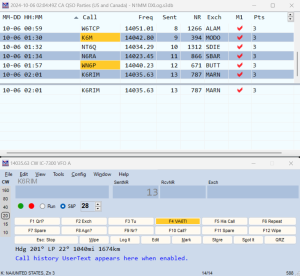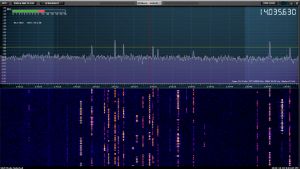I won’t bore you with a deep historical dive, but I will say that Morse code has been used by the military, commercial radio stations, and much more since its invention by Samuel Morse in the 1830s. It was, for many, a required skill, especially in the military. While still in use today, Morse Code is primarily recreational.
For years, Amateur Radio operators, otherwise known as Ham Radio operators or Hams for short, have had to take and pass a Morse code requirement in order to obtain their license. However, this requirement was dropped in 2007, as it was no longer deemed relevant. Its usage has since faded from the commercial space, as the last of the Morse stations have now gone silent. At the time, people were worried that this would spell the end of Morse code. So in 2024 this raises the question: Has Morse Code become obsolete?
In many ways yes, there are digital modes, voice, satellite comms, and so much more to explore within the hobby. But I will argue to the contrary, as demand appears to be high to learn this skill in particular. In fact, one only has to take a look at modern band plans to see that there is still a fair portion of the bands reserved for morse code or CW (continuous wave), as many hams refer to it.
These frequency spectrums, worth millions of dollars commercially, are reserved for amateur operation so we can explore and communicate with other operators throughout the world. Many suggest that it is a “use it or lose it” situation, and by my estimation, people have decided to use it.
California QSO Party 2024
Quantifying Morse Code usage is notoriously difficult, but if my recent participation in the California QSO party this past weekend (Oct 5-6, 2024) has shown anything, it’s that CW operators come out in full force for contests and QSO parties.
For the uninitiated a QSO party or a contest is an event where an exchange of information occurs. These brief exchanges typically contain a call sign, a signal report (Typically 599, which is customary in contests, representing readability, signal, and tone in CW), a unique serial number, and/or another piece of information like a state or location.
The events are highly organized and well resourced from a technological standpoint. The whole exchange takes a matter of seconds. Once complete, each station logs their contact, and at the end of the competition the logs are verified and points are issued, which will determine a winner. The points have multipliers that can accumulate depending on regions contacted, states, provinces, so operators can target specific contacts to get an advantage.

The image above is a screenshot from my activity in the California QSO party in 2024, using N1MM, a popular logger among Ham Radio contesters.
Some operators take contesting seriously and some are more casual. I myself take a casual approach to contests, as my modest home station can’t compete with the big guns, which often have multiple operators working around the clock to log as many contacts as possible. It doesn’t make it any less fun, in fact it likely enhances it, as I’m not glued to my station.
I find it very enjoyable to settle into the office / ham shack with a warm decaf in the evening and to admire the band activity that these types of events can create. I will casually make contacts for a few minutes and then move on to other life duties. Periodically checking back in as time permits. It makes for a stress-free and relaxing hobby.

This is an example of the band activity in the CW portion of the 20M band during the 2024 California QSO party.
CWOPS & LICW
Can these activities alone spark a Morse Code renaissance? For this to be a true CW era, I believe we need to look to groups such as CWOPS and the Long Island CW Club. I myself am a former student of CWOPS and a current member. These groups have a mandate to educate and propagate the usage of Morse Code, and they do it quite effectively. I also suspect that a lot of their interest is thanks to some heavy lifting from large and small content creators on YouTube, who often outline the merit of CW usage, especially QRP (a Q code used by CW operators to explain that they are using equipment that is generally 5 watts or lower). There are a variety of Q codes in use; you can read more about them here.
Radio Sport
The largest driving factor may be due to what I refer to as radio sport. Games such as Parks on the Air (POTA) and Summits on the Air (SOTA) have brought in hundreds of thousands of unique contacts annually. Not only are the games incredibly fun to participate in, but they have led to endless opportunities to practice your CW skills with easy QSO formulas (think exchanges) and a seemingly endless ability to find them thanks to internet spotting.
Parks On The Air
I got involved a few years back and racked up 1,836 QSO’s to date. Only 12 of them have been with voice communication; the rest have all been Morse code. I’ve met plenty of great people that I am in contact with to this day thanks to another facet of Ham Radio, that being QSL Cards… Again, another discussion for another day.
I had an email exchange with Matt (N3NWV) in preparation for this article, and he agreed with my premise, noting “CW is alive and well post dropping the requirement, and likely is in better shape than it would be had we kept the old rules. We’d for sure have far fewer hams if we still had the code requirement, and it takes hams to work CW. Forcing people to learn it did nothing to make them want to use it. Conversely, getting people into the hobby and having them discover the utility of CW (and that it’s actually in use) fosters growth in the mode.”
We generally recognize that CW doesn’t have the same global share that it would have in its heyday, but Matt suggested two other notable advancements which make sense to me:
- Transistor radios now exist and have driven down costs substantially, which has directly resulted in Hams having access to the wattages required to make SSB more reliable.
- The advent of affordable computers has led to a proliferation of digital modes, which has added a new modality to what was once a duopoly between voice and CW.

As we can see in the above chart supplied by Matt, CW tracks very well against phone in the modern era. Ultimately, they do tend to lag behind digital modes such as FT8, which has further gamified Ham Radio. It is worth noting that the decrease in 2024 is not alarming as POTA contacts generally lag and Matt suggests that there is a good chance that POTA will hit 10 million total QSO’s for 2024.
Conclusion
So, are we in our Morse Code era? I believe the enthusiasm shown and data put forward help to support this narrative. It is a wonderful mode to learn, and I would highly encourage anyone interested in contesting or participating in radio sport such as POTA or SOTA to take up the challenge and learn Morse Code as we approach 2025.
I’ll conclude by simply stating that Morse code seems to be flourishing, despite earlier predictions of its decline after the removal of the licensing requirement. I hope to see more people take up this mode in the near future, and I look forward to hearing you and perhaps working you on the bands.
73, Tyler Kacsor